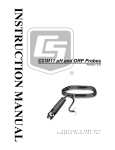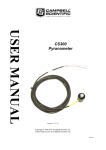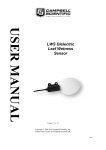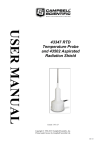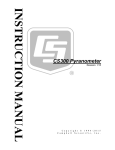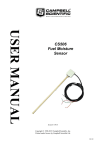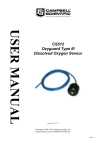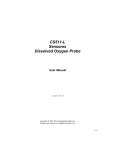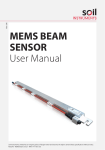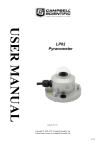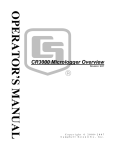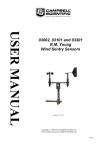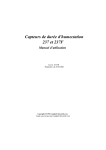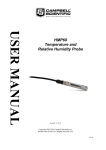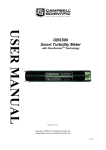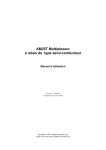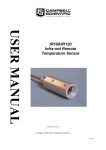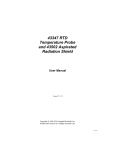Download Template for CSL manuals
Transcript
USER MANUAL 253 and 257 Soil Matric Potential Sensors Issued: 10.11.15 Copyright © 1993-2015 Campbell Scientific Inc. Printed under licence by Campbell Scientific Ltd. CSL 272 Guarantee This equipment is guaranteed against defects in materials and workmanship. We will repair or replace products which prove to be defective during the guarantee period as detailed on your invoice, provided they are returned to us prepaid. The guarantee will not apply to: Equipment which has been modified or altered in any way without the written permission of Campbell Scientific Batteries Any product which has been subjected to misuse, neglect, acts of God or damage in transit. Campbell Scientific will return guaranteed equipment by surface carrier prepaid. Campbell Scientific will not reimburse the claimant for costs incurred in removing and/or reinstalling equipment. This guarantee and the Company’s obligation thereunder is in lieu of all other guarantees, expressed or implied, including those of suitability and fitness for a particular purpose. Campbell Scientific is not liable for consequential damage. Please inform us before returning equipment and obtain a Repair Reference Number whether the repair is under guarantee or not. Please state the faults as clearly as possible, and if the product is out of the guarantee period it should be accompanied by a purchase order. Quotations for repairs can be given on request. It is the policy of Campbell Scientific to protect the health of its employees and provide a safe working environment, in support of this policy a “Declaration of Hazardous Material and Decontamination” form will be issued for completion. When returning equipment, the Repair Reference Number must be clearly marked on the outside of the package. Complete the “Declaration of Hazardous Material and Decontamination” form and ensure a completed copy is returned with your goods. Please note your Repair may not be processed if you do not include a copy of this form and Campbell Scientific Ltd reserves the right to return goods at the customers’ expense. Note that goods sent air freight are subject to Customs clearance fees which Campbell Scientific will charge to customers. In many cases, these charges are greater than the cost of the repair. Campbell Scientific Ltd, 80 Hathern Road, Shepshed, Loughborough, LE12 9GX, UK Tel: +44 (0) 1509 601141 Fax: +44 (0) 1509 601091 Email: [email protected] www.campbellsci.co.uk PLEASE READ FIRST About this manual Please note that this manual was originally produced by Campbell Scientific Inc. primarily for the North American market. Some spellings, weights and measures may reflect this origin. Some useful conversion factors: Area: 1 in2 (square inch) = 645 mm2 Length: 1 in. (inch) = 25.4 mm 1 ft (foot) = 304.8 mm 1 yard = 0.914 m 1 mile = 1.609 km Mass: 1 oz. (ounce) = 28.35 g 1 lb (pound weight) = 0.454 kg Pressure: 1 psi (lb/in2) = 68.95 mb Volume: 1 UK pint = 568.3 ml 1 UK gallon = 4.546 litres 1 US gallon = 3.785 litres In addition, while most of the information in the manual is correct for all countries, certain information is specific to the North American market and so may not be applicable to European users. Differences include the U.S standard external power supply details where some information (for example the AC transformer input voltage) will not be applicable for British/European use. Please note, however, that when a power supply adapter is ordered it will be suitable for use in your country. Reference to some radio transmitters, digital cell phones and aerials may also not be applicable according to your locality. Some brackets, shields and enclosure options, including wiring, are not sold as standard items in the European market; in some cases alternatives are offered. Details of the alternatives will be covered in separate manuals. Part numbers prefixed with a “#” symbol are special order parts for use with non-EU variants or for special installations. Please quote the full part number with the # when ordering. Recycling information At the end of this product’s life it should not be put in commercial or domestic refuse but sent for recycling. Any batteries contained within the product or used during the products life should be removed from the product and also be sent to an appropriate recycling facility. Campbell Scientific Ltd can advise on the recycling of the equipment and in some cases arrange collection and the correct disposal of it, although charges may apply for some items or territories. For further advice or support, please contact Campbell Scientific Ltd, or your local agent. Campbell Scientific Ltd, 80 Hathern Road, Shepshed, Loughborough, LE12 9GX, UK Tel: +44 (0) 1509 601141 Fax: +44 (0) 1509 601091 Email: [email protected] www.campbellsci.co.uk Precautions DANGER — MANY HAZARDS ARE ASSOCIATED WITH INSTALLING, USING, MAINTAINING, AND WORKING ON OR AROUND TRIPODS, TOWERS, AND ANY ATTACHMENTS TO TRIPODS AND TOWERS SUCH AS SENSORS, CROSSARMS, ENCLOSURES, ANTENNAS, ETC. FAILURE TO PROPERLY AND COMPLETELY ASSEMBLE, INSTALL, OPERATE, USE, AND MAINTAIN TRIPODS, TOWERS, AND ATTACHMENTS, AND FAILURE TO HEED WARNINGS, INCREASES THE RISK OF DEATH, ACCIDENT, SERIOUS INJURY, PROPERTY DAMAGE, AND PRODUCT FAILURE. TAKE ALL REASONABLE PRECAUTIONS TO AVOID THESE HAZARDS. CHECK WITH YOUR ORGANIZATION'S SAFETY COORDINATOR (OR POLICY) FOR PROCEDURES AND REQUIRED PROTECTIVE EQUIPMENT PRIOR TO PERFORMING ANY WORK. Use tripods, towers, and attachments to tripods and towers only for purposes for which they are designed. Do not exceed design limits. Be familiar and comply with all instructions provided in product manuals. Manuals are available at www.campbellsci.eu or by telephoning +44(0) 1509 828 888 (UK). You are responsible for conformance with governing codes and regulations, including safety regulations, and the integrity and location of structures or land to which towers, tripods, and any attachments are attached. Installation sites should be evaluated and approved by a qualified engineer. If questions or concerns arise regarding installation, use, or maintenance of tripods, towers, attachments, or electrical connections, consult with a licensed and qualified engineer or electrician. General • Prior to performing site or installation work, obtain required approvals and permits. Comply with all governing structure-height regulations, such as those of the FAA in the USA. • Use only qualified personnel for installation, use, and maintenance of tripods and towers, and any attachments to tripods and towers. The use of licensed and qualified contractors is highly recommended. • Read all applicable instructions carefully and understand procedures thoroughly before beginning work. • Wear a hardhat and eye protection, and take other appropriate safety precautions while working on or around tripods and towers. • Do not climb tripods or towers at any time, and prohibit climbing by other persons. Take reasonable precautions to secure tripod and tower sites from trespassers. • Use only manufacturer recommended parts, materials, and tools. Utility and Electrical • You can be killed or sustain serious bodily injury if the tripod, tower, or attachments you are installing, constructing, using, or maintaining, or a tool, stake, or anchor, come in contact with overhead or underground utility lines. • Maintain a distance of at least one-and-one-half times structure height, or 20 feet, or the distance required by applicable law, whichever is greater, between overhead utility lines and the structure (tripod, tower, attachments, or tools). • Prior to performing site or installation work, inform all utility companies and have all underground utilities marked. • Comply with all electrical codes. Electrical equipment and related grounding devices should be installed by a licensed and qualified electrician. Elevated Work and Weather • Exercise extreme caution when performing elevated work. • Use appropriate equipment and safety practices. • During installation and maintenance, keep tower and tripod sites clear of un-trained or non-essential personnel. Take precautions to prevent elevated tools and objects from dropping. • Do not perform any work in inclement weather, including wind, rain, snow, lightning, etc. Maintenance • Periodically (at least yearly) check for wear and damage, including corrosion, stress cracks, frayed cables, loose cable clamps, cable tightness, etc. and take necessary corrective actions. • Periodically (at least yearly) check electrical ground connections. WHILE EVERY ATTEMPT IS MADE TO EMBODY THE HIGHEST DEGREE OF SAFETY IN ALL CAMPBELL SCIENTIFIC PRODUCTS, THE CUSTOMER ASSUMES ALL RISK FROM ANY INJURY RESULTING FROM IMPROPER INSTALLATION, USE, OR MAINTENANCE OF TRIPODS, TOWERS, OR ATTACHMENTS TO TRIPODS AND TOWERS SUCH AS SENSORS, CROSSARMS, ENCLOSURES, ANTENNAS, ETC. Contents PDF viewers: These page numbers refer to the printed version of this document. Use the PDF reader bookmarks tab for links to specific sections. 1. Introduction ................................................................ 1 2. Cautionary Statements .............................................. 1 3. Initial Inspection ........................................................ 1 4. Quickstart ................................................................... 2 4.1.1 4.1.2 257 SCWin Programming ............................................................. 2 253 SCWin Programming ............................................................. 5 5. Overview ..................................................................... 8 6. Specifications .......................................................... 10 7. Operation .................................................................. 10 7.1 7.2 Installation/Removal .......................................................................... 10 Wiring ................................................................................................ 11 7.2.1 257 Wiring .................................................................................. 11 7.2.2 253 Wiring .................................................................................. 12 7.3 Programming...................................................................................... 14 7.3.1 BRHalf Instruction ...................................................................... 14 7.3.2 Resistance Calculation ................................................................ 14 7.3.3 Soil Water Potential Calculation ................................................. 15 7.3.3.1 Linear Relationship .......................................................... 15 7.3.3.2 Non-Linear Relationship .................................................. 15 7.3.3.3 Soil Water Matric Potential in Other Units ...................... 16 7.4 Interpreting Results ............................................................................ 17 8. Troubleshooting ...................................................... 17 9. Reference ................................................................. 18 Appendices A. Importing Short Cut Code ..................................... A-1 B. Example Programs ................................................ B-1 B.1 257 Program Examples .................................................................... B-1 B.1.1 CR6 Program Measuring a 107 and 257 ................................... B-2 B.1.2 CR1000 Program Measuring a 107 and 257 ............................. B-2 B.2 253 Program Example ...................................................................... B-3 B.2.1 CR1000 Program Measuring Five 107s and Five 257s ............. B-3 Figures 5-1. 7-1. 7-2. 257 Soil Matric Potential Sensor with capacitor circuit and completion resistor installed in cable. Model 253 is the same, except that it does not have completion circuitry in the cable. ......... 9 257 schematic .................................................................................... 12 253 wiring example............................................................................ 13 7-1. 7-2. 7-3. 7-4. 7-5. 7-6. B-1. B-2. 257 Wiring ......................................................................................... 11 257-to AM16/32-series Multiplexer Wiring ...................................... 12 Datalogger to AM16/32-series Multiplexer Wiring (2 x 32 Mode) ... 13 Excitation and Voltage Ranges for CRBasic Dataloggers ................. 14 Comparison of Estimated Soil Water Potential and Rs at 21 °C ........ 16 Conversion of Matric Potential to Other Units .................................. 16 107/257 Wiring for Example Program ............................................. B-1 Wiring for 253 Example .................................................................. B-3 Tables ii 253 and 257 Soil Matric Potential Sensors 1. Introduction The 253 and 257 soil matric potential sensors are solid-state, electrical-resistance sensing devices with a granular matrix that estimate soil water potential between 0 and –2 bars (typically wetter or irrigated soils). The 253 needs to be connected to an AM16/32-series multiplexer, and is intended for applications where a larger number of sensors will be monitored. The 257 connects directly to our dataloggers. NOTE 2. 3. This manual provides information only for CRBasic dataloggers. It is also compatible with our retired Edlog dataloggers. For Edlog datalogger support, see an older manual at www.campbellsci.com/old-manuals or contact a Campbell Scientific application engineer for assistance. Cautionary Statements READ AND UNDERSTAND the Precautions section at the front of this manual. The black outer jacket of the cable is Santoprene® rubber. This jacket will support combustion in air. It is rated as slow burning when tested according to U.L. 94 H.B. and will pass FMVSS302. Local fire codes may preclude its use inside buildings. Avoid installing in depressions where water will puddle after a rain storm. Don’t place the 253 or 257 in high spots or near changes in slope unless wanting to measure the variability created by such differences. When removing the sensor prior to harvest of annual crops, do so just after the last irrigation when the soil is moist. When removing a sensor, do not pull the sensor out by its wires. Careful removal prevents sensor and membrane damage. Initial Inspection Upon receipt of a 253 or 257, inspect the packaging and contents for damage. File damage claims with the shipping company. The model number and cable length are printed on a label at the connection end of the cable. Check this information against the shipping documents to ensure the correct product and cable length are received. 1 253 and 257 Soil Matric Potential Sensors 4. Quickstart Short Cut is an easy way to program your datalogger to measure the 253 or 257 and assign datalogger wiring terminals. The following sections show using Short Cut to program the 253 and 257. NOTE Short Cut requires the use of a soil temperature sensor before the 253 or 257 sensor is added. This is needed because there is a temperature correction factor in the equations that convert sensor resistance. In these Quickstart examples, a 107-L temperature probe is used to measure soil temperature. 4.1.1 257 SCWin Programming 2 1. Install Short Cut by clicking on the install file icon. Get the install file from either www.campbellsci.com, the ResourceDVD, or find it in installations of LoggerNet, PC200W, PC400, or RTDAQ software. 2. The Short Cut installation should place a shortcut icon on the desktop of your computer. To open Short Cut, click on this icon. 3. When Short Cut opens, select New Program. User Manual 4. Select Datalogger Model and Scan Interval (default of 5 seconds is OK for most applications). Click Next. 5. Under the Available Sensors and Devices list, select the Sensors folder, then select the Temperature sub-folder. Select 107 Temperature Probe. Click to move the selection to the Selected device window. Use the default units of degree Celsius. Click OK. 3 253 and 257 Soil Matric Potential Sensors 6. Under the Available Sensors and Devices list, select the Sensors | Meteorological | Soil Moisture | 257 Soil Moisture Sensor. Click to move the selection to the Selected device window. Select the resistance units, soil water units, soil water potential range, and soil reference temperature. 4 7. After selecting the sensor, click at the left of the screen on Wiring Diagram to see how the sensor is to be wired to the datalogger. The wiring diagram can be printed out now or after more sensors are added. 8. Select any other sensors you have, then finish the remaining Short Cut steps to complete the program. The remaining steps are outlined in Short Cut Help, which is accessed by clicking on Help | Contents | Programming Steps. User Manual 9. If LoggerNet, PC400, RTDAQ, or PC200W is running on your PC, and the PC to datalogger connection is active, you can click Finish in Short Cut and you will be prompted to send the program just created to the datalogger. 10. If the sensors are connected to the datalogger, as shown in the wiring diagram in step 7, check the output of the sensors in the datalogger support software data display to make sure it is making reasonable measurements. 4.1.2 253 SCWin Programming NOTE 1. Install Short Cut by clicking on the install file icon. Get the install file from either www.campbellsci.com, the ResourceDVD, or find it in installations of LoggerNet, PC200W, PC400, or RTDAQ software. 2. The Short Cut installation should place a shortcut icon on the desktop of your computer. To open Short Cut, click on this icon. 3. When Short Cut opens, select New Program. 4. Select the datalogger and enter the scan interval, and select Next. A scan rate of 30 seconds or longer is recommended when using a multiplexer. 5 253 and 257 Soil Matric Potential Sensors 5. Under the Available Sensors and Devices list, select the Sensors folder, then select the Temperature sub-folder. Select 107 Temperature Probe. Click to move the selection to the Selected device window. Use the default units of degree Celsius. Click OK. 6 User Manual 6. Under the Available Sensors and Devices list, select Devices folder, then select AM16/32. Click window. 7. to move the selection to the Selected device Under the Sensors list, select the Meteorological | Soil Moisture | 253 Soil Moisture Sensor. Click to move the selection to the Selected device window. Select the number of sensors, resistance units, soil water potential units, soil water potential range, and soil reference temperature. 7 253 and 257 Soil Matric Potential Sensors 8. After selecting the sensor, click at the left of the screen on Wiring Diagram to see how the sensor is to be wired to the datalogger. The wiring diagram can be printed out now or after more sensors are added. 9. Select any other sensors you have, then finish the remaining Short Cut steps to complete the program. The remaining steps are outlined in Short Cut Help, which is accessed by clicking on Help | Contents | Programming Steps. 10. If LoggerNet, PC400, RTDAQ, or PC200W is running on your PC, and the PC to datalogger connection is active, you can click Finish in Short Cut and you will be prompted to send the program just created to the datalogger. 11. If the sensors are connected to the datalogger, as shown in the wiring diagram in step 8, check the output of the sensors in the datalogger support software data display to make sure it is making reasonable measurements. 5. Overview The 253 and 257 soil matric potential sensors provide a convenient method of estimating water potential of wetter soils in the range of 0 to –200 kPa. The 253 is the Watermark 200 Soil Matric Potential Block modified for use with Campbell Scientific multiplexers and the 257 is the Watermark 200 Soil Matric Potential Block modified for use with Campbell Scientific dataloggers. This manual refers to the sensors as the 257 and 253. The typical cable length for the 257 is 25 ft. The following two cable termination options are offered for the 257: Connector that attaches to a prewired enclosure (cable termination option –PW). For 253 applications, most of the cable length used is between the datalogger and the multiplexer, which reduces overall cable costs and allows each cable attached to the 253 to be shorter. The cable length of each 253 only needs to cover the distance from the multiplexer to the point of measurement. Typical cable length for the 253 is 8 to 15 m. The difference between the 253 and the 257 is that there is a capacitor circuit and completion resistor installed in the 257 cable (Figure 5-1) to allow for direct 8 User Manual connection to a datalogger, while the 253 does not have any added circuitry. For applications requiring many sensors on an analogue multiplexer, the 253 is used and one or more completion resistors are connected to the datalogger wiring panel. A capacitor circuit is not required for the 253 on a multiplexer because the electrical connection between the sensor and the datalogger is interrupted when the multiplexer is deactivated. Any potential difference between the datalogger earth ground and the electrodes in the sensor is thus eliminated. The 253 and 257 consist of two concentric electrodes embedded in a reference granular matrix material. The granular matrix material is surrounded by a synthetic membrane for protection against deterioration. An internal gypsum tablet buffers against the salinity levels found in irrigated soils. If cultivation practices allow, the sensor can be left in the soil all year, eliminating the need to remove the sensor during the winter months. Figure 5-1. 257 Soil Matric Potential Sensor with capacitor circuit and completion resistor installed in cable. Model 253 is the same, except that it does not have completion circuitry in the cable. 9 253 and 257 Soil Matric Potential Sensors 6. Specifications Features: 7. Survives freeze-thaw cycles Rugged, long-lasting sensor Buffers salts in soil No maintenance required The 257 contains blocking capacitors in its cable that minimizes galvanic degradation and measurement errors due to ground loops For the 253, the multiplexer connection prevents electrolysis from prematurely destroying the probe Compatible with Campbell Scientific CRBasic Dataloggers: CR6, CR800-series, CR1000, CR3000, and CR5000 Range: 0 to –200 kPa Dimensions: 8.26 cm (3.25 in) Diameter: 1.91 cm (0.75 in) Weight: 363 g (0.8 lb) Operation If you are programming your datalogger with Short Cut, skip Section 7.2, Wiring (p. 11), and Section 7.3, Programming (p. 14). Short Cut does this work for you. See Section 4, Quickstart (p. 2), for a Short Cut tutorial. 7.1 Installation/Removal NOTE 10 Placement of the sensor is important. To acquire representative measurements, avoid high spots, slope changes, or depressions where water puddles. Typically, the sensor should be located in the root system of the crop. 1. Soak sensors in water for one hour then allow them to dry, ideally for 1 to 2 days. 2. Repeat Step 1 twice if time permits. 3. Make the sensor access holes to the required depth. Often, a 22 mm (7/8 in) diameter rod can be used to make the hole. However, if the soil is very coarse or gravelly, an oversized hole (25 to 32 mm) may be required to prevent abrasion damage to the sensor membrane. The ideal method of making an oversized access hole is to have a stepped tool that makes an oversized hole for the upper portion and an exact size hole for the lower portion. 4. If the hole is oversized (25 to 32 mm), mix a slurry of soil and water to a creamy consistency and place it into the sensor access hole. 5. Insert the sensors in the sensor access hole. A length of 1/2 inch class 315 PVC pipe fits snugly over the sensor collar and can be used to push in the sensor. The PVC can be left in place with the wires threaded through the pipe and the open end taped shut (duct tape is adequate). This practice also simplifies the removal of the sensors. When using PVC piping, solvent weld the PVC pipe to the sensor collar. Use PVC/ABS cement on the stainless User Manual steel sensors with the green top. Use clear PVC cement only on the PVC sensors with the grey top. 6. NOTE CAUTION Snug fit in the soil is extremely important. Lack of a snug fit is the premier problem with sensor effectiveness. 7. Carefully, back fill the hole, and tamp down to prevent air pockets which could allow water to channel down to the sensor. 8. When removing sensors prior to harvest in annual crops, do so just after the last irrigation when the soil is moist. Do not pull the sensor out by the wires. prevents sensor and membrane damage. 9. 7.2 Force the soil or slurry to envelope the sensors. This will ensure uniform soil contact. Careful removal When sensors are removed for winter storage, clean, dry, and place them in a plastic bag. Wiring 7.2.1 257 Wiring The 257’s cable includes a capacitor circuit that stops galvanic action due to the differences in potential between the datalogger earth ground and the electrodes in the block. This allows it to connect directly to a datalogger (Table 7-1 and Figure 7-1). Table 7-1. 257 Wiring Wire Colour Wire Function Datalogger Connection Terminal Black Voltageexcitation input U configured for voltage excitation1, EX, VX (voltage excitation) Red Analoguevoltage output U configured for single-ended analogue input1, SE (single-ended, analoguevoltage input) White Negative signal AG or ⏚ (analogue ground) Clear Shield AG or ⏚ (analogue ground) 1 U channels are automatically configured by the measurement instruction. 11 253 and 257 Soil Matric Potential Sensors VX or EX 1K 1% BLACK RED 100 fd SE Rs WHITE AG or CLEAR Figure 7-1. 257 schematic 7.2.2 253 Wiring The 253 typically connects to an AM16/32-series multiplexer (Table 7-2), but it also is compatible with the long retired AM32 and AM416 multiplexers. Table 7-2. 257-to AM16/32-series Multiplexer Wiring Wire Colour Wire Function Multiplexer Connection Terminal White Voltage-excitation input H Black Analogue-voltage output L Clear Shield or ⏚ (ground) The multiplexer connects to the datalogger (refer to the multiplexer manual or www.campbellsci.com/am16-32b-ordering for information on the cables available for connecting the multiplexer to the datalogger). A 1000 ohm resistor at the datalogger wiring panel is used to complete the half bridge circuitry. Table 7-3 and Figure 7-2 show the datalogger-to-multiplexer connections for the 2 x 32 mode. Appendix B.2, 253 Program Example (p. B-3), shows wiring for the 4 x 16 mode. 12 User Manual Table 7-3. Datalogger to AM16/32-series Multiplexer Wiring (2 x 32 Mode) Datalogger Connection Terminal Multiplexer Connection Terminal 12V 12V G G C (control port) RES C (control port) CLK U configured for voltage excitation1, EX, VX (voltage excitation) 1000 Ω resistor U configured for single-ended analogue input1, SE (singleended, analogue-voltage input) COM ODD H AG or ⏚ (analogue ground) COM ODD L AG or ⏚ (analogue ground) COM or ⏚ (ground) 1 U channels are automatically configured by the measurement instruction. Figure 7-2. 253 wiring example 13 253 and 257 Soil Matric Potential Sensors 7.3 Programming Short Cut is the best source for up-to-date datalogger programming code. Programming code is needed, when creating a program for a new datalogger installation when adding sensors to an existing datalogger program If your data acquisition requirements are simple, you can probably create and maintain a datalogger program exclusively with Short Cut. If your data acquisition needs are more complex, the files that Short Cut creates are a great source for programming code to start a new program or add to an existing custom program. NOTE Short Cut cannot edit programs after they are imported and edited in CRBasic Editor. A Short Cut tutorial is available in Section 4, Quickstart (p. 2). If you wish to import Short Cut code into CRBasic Editor to create or add to a customized program, follow the procedure in Appendix A, Importing Short Cut Code (p. A-1). Programming basics for CRBasic dataloggers are in the following sections. Complete program examples for select CRBasic dataloggers can be found in Appendix B, Example Programs (p. B-1). Programming basics and programming examples for Edlog dataloggers are provided at www.campbellsci.com/oldmanuals. 7.3.1 BRHalf Instruction CRBasic dataloggers use the BRHalf() instruction with the RevEx argument set to True to excite and measure the 253 and 257. The result of the BRHalf() instruction is the ratio of the measured voltage divided by the excitation voltage. The result needs to be converted to resistance and then converted to soil water potential. Table 7-4 shows the excitation and voltage ranges used with the CRBasic dataloggers. Table 7-4. Excitation and Voltage Ranges for CRBasic Dataloggers Datalogger mV excitation Full Scale Range CR800 Series 250 ± 250 mV CR6 200 ± 200 mV CR1000 250 ± 250 mV CR3000 200 ± 200 mV CR5000 200 ± 200 mV 7.3.2 Resistance Calculation The CRBasic program should include an expression that calculates resistance. If the result of the BRHalf() instruction is assigned to a variable called kOhms, then use the following expression to calculate resistance: kOhms = 1 * (kOhms/(1-kOhms)) 14 User Manual where the 1 represents the value of the reference resistor in kOhms and can be omitted from the expression if desired. 7.3.3 Soil Water Potential Calculation The datalogger calculates soil water potential (kPa) from the sensor resistance (Rs) and soil temperature (Ts). Soil temperatures vary widely where placement is shallow and solar radiation impinges on the soil surface. A soil temperature measurement may be needed in such situations, particularly in research applications. Many applications, however, require deep placement (12 to 25 cm) in soils shaded by a crop canopy. A common practice for deep or shaded sensors is to assume the air temperature at sunrise will be close to what the soil temperature will be for the day. The equation used to calculate soil potential depends on whether the soil water potential and temperature responses are assumed to be linear or non-linear. The following sections describe the linear and non-linear relationships. Table 7-5 provides a comparison of the soil water potential estimates using the linear and non-linear equations. 7.3.3.1 Linear Relationship Assume the water potential and temperature responses are linear if the soil water potential will be in the range of 0 to –200 kPa (measurements beyond –125 kPa have not been verified, but work in practice). The following equation normalizes the resistance measurement to 21 °C. R21 Rs 1 0.018 * dT where R21 = resistance at 21 °C Rs = the measured resistance dT = Ts – 21 Ts = soil temperature Water potential is then calculated from R21 with the relationship, SWP 7.407 * R21 3.704 where SWP is soil water potential in kPa 7.3.3.2 Non-Linear Relationship For more precise work, calibration and temperature compensation in the range of 10 to 100 kPa has been refined by Thompson and Armstrong (1987), as defined in the non-linear equation, SWP Rs 0.01306[1.062(34.21 Ts 0.01060Ts ) Rs ] 2 where SWP is soil water potential in kPa 15 253 and 257 Soil Matric Potential Sensors Table 7-5. Comparison of Estimated Soil Water Potential and Rs at 21 °C kPa (NonLinear Equation) kPa (Linear Equation) (Rs) kOhms –3.7 1.00 –9 –11 2.00 –14 –18 3.00 –20 –26 4.00 –27 –33 5.00 –35 –41 6.00 –45 –48 7.00 –56 –56 8.00 –69 –63 9.00 –85 –70 10.00 –105 –78 11.00 –85 12.00 –92 13.00 –99 14.00 –107 15.00 –115 16.00 –122 17.00 –129 18.00 –144 20.00 –159 22.00 –174 24.00 –188 26.00 –199 27.50 7.3.3.3 Soil Water Matric Potential in Other Units To report measurement results in other units, multiply the result from the linear or non-linear equation by the appropriate conversion constant from Table 7-6. Table 7-6. Conversion of Matric Potential to Other Units 16 Desired Unit Multiply Result By kPa 1.0 MPa 0.001 Bar 0.01 User Manual 7.4 Interpreting Results As a general guide, 253 and 257 measurements indicate soil matric potential as follows: 0 to –10 kPa = –10 to –20 kPa = Soil is adequately wet (except coarse sands, which are beginning to lose water). –20 to –60 kPa = Usual range for irrigation (except heavy clay). –60 to –100 kPa = Usual range for irrigation for heavy clay soils. –100 to –200 kPa = 8. Saturated soil Soil is becoming dangerously dry for maximum production. Troubleshooting NOTE All factory repairs and recalibrations require a returned material authorization (RMA) and completion of the “Declaration of Hazardous Material and Decontamination” form. Refer to the Assistance page at the beginning of this manual for more information. To test the sensor, submerge it in water. Measurements should be from –3 to +3 kPa. Let the sensor dry for 30 to 48 hours. You should see the reading increase from 0 to 15,000+ kPa. If the reading does not increase to 15,000 kPA, replace the sensor. If the reading increases as expected, put the sensor back in the water. The reading should run right back down to zero in 1 to 2 minutes. If the sensor passes these tests but it is still not functioning properly, consider the following: 1. Sensor may not have a snug fit in the soil. This usually happens when an oversized access hole has been used and the backfilling of the area around the sensor is not complete. 2. Sensor is not in an active portion of the root system, or the irrigation is not reaching the sensor area. This can happen if the sensor is sitting on top of a rock or below a hard pan which may impede water movement. Re-installing the sensor usually solves this problem. 3. When the soil dries out to the point where you are seeing readings higher than 80 kPa, the contact between soil and sensor can be lost because the soil may start to shrink away from the sensor. An irrigation which only results in a partial rewetting of the soil will not fully rewet the sensor, which can result in continued high readings from the 257. Full rewetting of the soil and sensor usually restores soil to sensor contact. This is most often seen in the heavier soils and during peak crop water demand when irrigation may not be fully adequate. The plotting of readings on a chart is most useful in getting a good picture of this sort of behaviour. 17 253 and 257 Soil Matric Potential Sensors 9. Reference Thompson, S.J. and C.F. Armstrong, Calibration of the Watermark Model 200 Soil matric potential Sensor, Applied Engineering in Agriculture, Vol. 3, No. 2, pp. 186-189, 1987. Parts of this manual were contributed by Irrometer Company, Inc., manufacturer of the Watermark 200. 18 Appendix A. Importing Short Cut Code This tutorial shows: How to import a Short Cut program into a program editor for additional refinement How to import a wiring diagram from Short Cut into the comments of a custom program Short Cut creates files that can be imported into either CRBasic Editor. These files normally reside in the C:\campbellsci\SCWin folder and have the following extensions: .DEF (wiring and memory usage information) .CR6 (CR6 datalogger code) .CR1 (CR1000 datalogger code) .CR8 (CR800 datalogger code) .CR3 (CR3000 datalogger code) .CR5 (CR5000 datalogger code) Use the following procedure to import Short Cut code into CRBasic Editor. NOTE 1. Create the Short Cut program following the procedure in Section 4, Quickstart (p. 2). Finish the program and exit Short Cut. Make note of the file name used when saving the Short Cut program. 2. Open CRBasic Editor. 3. Click File | Open. Assuming the default paths were used when Short Cut was installed, navigate to C:\CampbellSci\SCWin folder. The file of interest has a “.CR6”, “.CR1”, “.CR8”, “.CR3”, or “.CR5” extension, for CR6, CR1000, CR800, CR3000, or CR5000 dataloggers, respectively. Select the file and click Open. 4. Immediately save the file in a folder different from \Campbellsci\SCWin, or save the file with a different file name. Once the file is edited with CRBasic Editor, Short Cut can no longer be used to edit the datalogger program. Change the name of the program file or move it, or Short Cut may overwrite it next time it is used. 5. The program can now be edited, saved, and sent to the datalogger. 6. Import wiring information to the program by opening the associated .DEF file. Copy and paste the section beginning with heading “-Wiring for CRXXX–” into the CRBasic program, usually at the head of the file. After pasting, edit the information such that a ' character (single quotation mark) begins each line. This character instructs the datalogger compiler to ignore the line when compiling the datalogger code. A-1 Appendix B. Example Programs These examples show programs written for the CR1000 and the CR6 dataloggers. With minor changes to excitation and voltage ranges, the code in the CR1000 examples will work with all compatible CRBasic dataloggers (see Table 7-4). B.1 257 Program Examples The following examples demonstrate the programming used to measure the resistance (k) of one 257 sensor with the datalogger. A 107 temperature probe is measured first for temperature correction of the 257 reading. The linear equation is used and the non-linear equation is included in the program notes. To use the non-linear equation, remove the linear equation from the program and uncomment the non-linear equation. Voltage range codes for other CRBasic dataloggers are shown in Table 7-4. Sensor wiring for this example is shown in Table B-1. Table B-1. 107/257 Wiring for Example Program Sensor Wire Function CR1000 CR6 107 Black Excitation VX1 U1 Red Positive Signal SE1 (1H) U2 Purple Negative Signal ⏚ ⏚ Clear Shield ⏚ ⏚ Black Excitation VX2 U4 Red Positive Signal SE2 (1L) U3 White Negative Signal ⏚ ⏚ Clear Shield ⏚ ⏚ 257 B-1 253-L and 257-L Soil Matric Potential Sensors B.1.1 CR6 Program Measuring a 107 and 257 'CR6 Public T107_C, kOhms, WP_kPa Units T107_C=Deg C Units kOhms=kOhms Units WP_kPa=kPa DataTable(Hourly,True,-1) DataInterval(0,60,Min,10) Average(1,T107_C,FP2,False) Sample(1,WP_kPa,FP2) EndTable BeginProg Scan(1,Sec,1,0) '107 Temperature Sensor measurement T107_C: Therm107(T107_C,1,U2,U1,0,60,1,0) '257 Soil matric potential Sensor measurements: BrHalf(kohms,1,mV200,U3,U4,1,200,True,0,250,1,0) kOhms=kOhms/(1-kOhms) 'Equation for linear (0 to 200 kPa) relationship WP_kPa=7.407*kOhms/(1-0.018*(T107_C-21))-3.704 'For non-linear (10 to 100 kPa) relationship, use the following equation: 'WP_kPa=kOhms/(0.01306*(1.062*(34.21-T107_C+0.01060*T107_C^2)-kOhms)) CallTable(Hourly) 'Call Data Table and Store Data NextScan EndProg B.1.2 CR1000 Program Measuring a 107 and 257 'CR1000 Public T107_C, kOhms, WP_kPa Units T107_C=Deg C Units kOhms=kOhms Units WP_kPa=kPa DataTable(Hourly,True,-1) DataInterval(0,60,Min,10) Average(1,T107_C,FP2,False) Sample(1,WP_kPa,FP2) EndTable BeginProg Scan(1,Sec,1,0) '107 Temperature Sensor measurement T107_C: Therm107(T107_C,1,1,1,0,_60Hz,1.0,0.0) '257 Soil matric potential Sensor measurements: BrHalf(kOhms,1,mV250,2,Vx2,1,250,True,0,250,1,0) kOhms=kOhms/(1-kOhms) 'Equation for linear (0 to 200 kPa) relationship WP_kPa=7.407*kOhms/(1-0.018*(T107_C-21))-3.704 'For non-linear (10 to 100 kPa) relationship, use the following equation: 'WP_kPa=kOhms/(0.01306*(1.062*(34.21-T107_C+0.01060*T107_C^2)-kOhms)) CallTable(Hourly) 'Call Data Table and Store Data NextScan EndProg B-2 253-L and 257-L Soil Matric Potential Sensors B.2 253 Program Example B.2.1 CR1000 Program Measuring Five 107s and Five 257s The following example demonstrates the programming used to measure five 107 temperature probes and five 253 sensors on an AM16/32-series multiplexer (4x16 mode) with the CR1000 datalogger. In this example, a 107 temperature probe is buried at the same depth as a corresponding 253 sensor. The linear equation is used and the non-linear equation is included in the program notes. To use the nonlinear equation, remove the linear equation from the program and uncomment the non-linear equation. Voltage range codes for other CRBasic dataloggers are shown in Table 7-4. Sensor wiring is shown in Table B-2. Table B-2. Wiring for 253 Example CR1000 AM16/32 Sensor Wire Function 12V 12V G GND C1 RES C2 CLK VX1 COM ODD H SE1 (1H) COM ODD L Ground COM GROUND SE2 (1L) COM EVEN H Ground COM EVEN L 107 Black Excitation 1L Red Positive Signal GROUND Purple Negative Signal GROUND Clear Shield White Positive Signal 2L Black Negative Signal GROUND Clear Shield 1000 ohm resistor from SE2 to VX2 1H 2H 253 Continue wiring sensors to multiplexer with 107 probes attaching to odd numbered channels and 253 sensors to even numbered channels. AM16/32 in 4x16 mode. B-3 253-L and 257-L Soil Matric Potential Sensors ‘CR1000 Public T107_C(5), WP_kPa(5), kOhms(5) Dim i Units T107_C()=Deg C Units kOhms=kOhms Units WP_kPa=kPa DataTable(Hourly,true,-1) DataInterval(0,60,Min,10) Average(5, T107_C, FP2, 0) Sample(5, WP_kPa, FP2) Sample(5, kOhms, FP2) EndTable BeginProg Scan(60,Sec, 3, 0) PortSet(1,1) 'Turn AM16/32 Multiplexer On Delay(0,150,mSec) i = 1 SubScan (0,uSec,5) PulsePort(2,10000) 'Soil temperature measurement Therm107(T107_C(i),1,1,VX1,0,250,1,0) '253 Soil Moisture Sensor measurements BrHalf(kOhms(i),1,mV250,2,VX2,1,250,true,0,250,1,0) 'Convert resistance ratios to kOhms kOhms(i) = kOhms(i)/(1-kOhms(i)) i = i+1 NextSubScan PortSet(1,0) 'Turn AM16/32 Multiplexer Off 'Convert kOhms to water potential For i = 1 To 5 'For linear equation (0 - 200 kPa) use this equation: WP_kPa(i)=7.407*kOhms(i)/(1-0.018*(T107_C(i)-21))-3.704 'For non-linear equation (10 - 100 kPa) uncomment and use this equation: 'WP_kPa(i) = kOhms(i)/(0.01306*(1.062*(34.21-T107_C(i)+0.0106*T107_C(i)^2))-kOhms(i)) Next i CallTable Hourly 'Call Data Table and Store Data NextScan EndProg B-4 CAMPBELL SCIENTIFIC COMPANIES Campbell Scientific, Inc. (CSI) 815 West 1800 North Logan, Utah 84321 UNITED STATES www.campbellsci.com [email protected] Campbell Scientific Africa Pty. Ltd. (CSAf) PO Box 2450 Somerset West 7129 SOUTH AFRICA www.csafrica.co.za [email protected] Campbell Scientific Australia Pty. Ltd. (CSA) PO Box 8108 Garbutt Post Shop QLD 4814 AUSTRALIA www.campbellsci.com.au [email protected] Campbell Scientific do Brazil Ltda. (CSB) Rua Apinagés, nbr. 2018 - Perdizes CEP: 01258-00 São Paulo SP BRAZIL www.campbellsci.com.br [email protected] Campbell Scientific Canada Corp. (CSC) 14532 – 131 Avenue NW Edmonton, Alberta T5L 4X4 CANADA www.campbellsci.ca [email protected] Campbell Scientific Centro Caribe S.A. (CSCC) 300N Cementerio, Edificio Breller Santo Domingo, Heredia 40305 COSTA RICA www.campbellsci.cc [email protected] Campbell Scientific Ltd. (CSL) 80 Hathern Road, Shepshed, Loughborough LE12 9GX UNITED KINGDOM www.campbellsci.co.uk [email protected] Campbell Scientific Ltd. (France) 3 Avenue de la Division Leclerc 92160 ANTONY FRANCE www.campbellsci.fr [email protected] Campbell Scientific Spain, S. L. Avda. Pompeu Fabra 7-9 Local 1 - 08024 BARCELONA SPAIN www.campbellsci.es [email protected] Campbell Scientific Ltd. (Germany) Fahrenheitstrasse13, D-28359 Bremen GERMANY www.campbellsci.de [email protected] Campbell Scientific (Beijing) Co., Ltd. 8B16, Floor 8 Tower B, Hanwei Plaza 7 Guanghua Road, Chaoyang, Beijing 100004 P.R. CHINA www.campbellsci.com [email protected] Please visit www.campbellsci.com to obtain contact information for your local US or International representative.




































